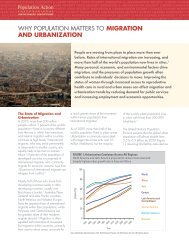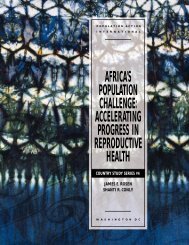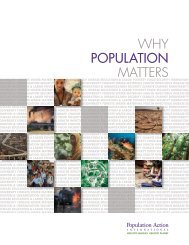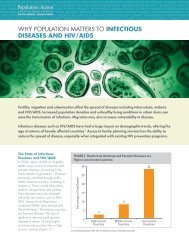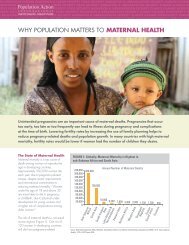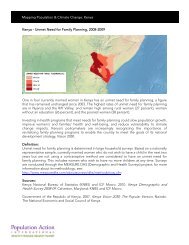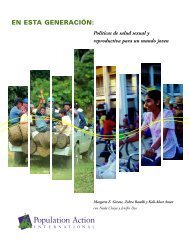Sustaining water, easing scarcity - Population Action International
Sustaining water, easing scarcity - Population Action International
Sustaining water, easing scarcity - Population Action International
You also want an ePaper? Increase the reach of your titles
YUMPU automatically turns print PDFs into web optimized ePapers that Google loves.
for long, especially as their populations continue<br />
to grow, their pumping costs begin to escalate<br />
and their development requires greater<br />
quantities of <strong>water</strong>.<br />
In addition, the <strong>water</strong> availability figures<br />
take no account of the timing or seasonality<br />
of this availability. Fresh <strong>water</strong> is often more<br />
abundant in some seasons than in others.<br />
Throughout the tropics, for example, rainy seasons<br />
often produce deluges of renewable fresh<br />
<strong>water</strong> that cause damaging floods and can<br />
scarcely be captured for later use. Months later<br />
the dry season sets in, drying rivers and streams<br />
to a trickle and causing severe, though temporary,<br />
fresh<strong>water</strong> shortages. Under these circumstances,<br />
a <strong>water</strong>shed or country that in theory<br />
has sufficient <strong>water</strong> for its inhabitants can face<br />
shortages not accounted for by the annual<br />
availability of renewable fresh <strong>water</strong>. Much<br />
more data on seasonal inventories of fresh<strong>water</strong><br />
availability will be needed before the concept of<br />
timing can play a significant role in analyses of<br />
population and <strong>water</strong> relationships.<br />
As previously discussed, the ability of individuals<br />
and institutions to adapt to different<br />
challenges can obviously vary widely among<br />
nations. For this reason, some can naturally<br />
manage better than others as the per capita<br />
availability of renewable fresh <strong>water</strong> declines.<br />
It would be inappropriate, therefore, to propose<br />
any precise levels as absolute thresholds of<br />
<strong>water</strong> <strong>scarcity</strong>, or insist that they apply equally<br />
to all countries. Instead we use the term benchmark<br />
to convey that these figures represent<br />
approximate levels of fresh<strong>water</strong> availability—<br />
averaged over different climates, soil conditions<br />
and economic development levels—below<br />
which concern about <strong>water</strong> shortage tends<br />
to rise significantly. By applying these approximate<br />
benchmarks, we can establish a framework<br />
that helps explain how population<br />
dynamics interact with finite resources such<br />
as renewable fresh <strong>water</strong>.<br />
Finally, the benchmarks described here<br />
are not meant to imply that countries having<br />
more than 1,700 cubic meters of renewable<br />
fresh <strong>water</strong> available to each inhabitant are<br />
automatically considered <strong>water</strong> abundant.<br />
This term proved to be misleading when<br />
used in <strong>Sustaining</strong> Water: <strong>Population</strong> and the<br />
Future of Renewable Water Supplies because<br />
in many countries—from India to Iran to the<br />
United States—the per capita <strong>water</strong> availability<br />
is higher than the 1,700 cubic meter stress<br />
benchmark, yet the drier regions of these<br />
countries experience significant <strong>water</strong> shortages<br />
at times. In addition, although countries<br />
may appear to have a plentiful supply of<br />
renewable <strong>water</strong>, not all of these sources can<br />
be exploited at an acceptable cost, given their<br />
location relative to population centers. Thus<br />
the supply of economically available fresh<br />
<strong>water</strong> is often much lower than the estimates<br />
provided here. In this update of <strong>Sustaining</strong><br />
Water, the term relative <strong>water</strong> sufficiency conveys<br />
the fact that countries with a per capita<br />
<strong>water</strong> availability in excess of the stress and<br />
<strong>scarcity</strong> benchmarks are not guaranteed an<br />
abundant fresh<strong>water</strong> supply in all times and<br />
in all places. Even the term “sufficiency”<br />
often overstates the reality of fresh<strong>water</strong><br />
availability in these countries—in the United<br />
States the examples of southern California,<br />
the Florida Everglades and south Texas come<br />
to mind. Nonetheless, it seems the most apt<br />
term to describe the condition of renewable<br />
<strong>water</strong> resources in countries with a per capita<br />
renewable fresh<strong>water</strong> supply that exceeds<br />
the benchmark levels for <strong>water</strong> stress or<br />
<strong>scarcity</strong> described in this update.<br />
11



